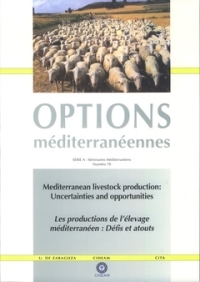| Article précédent | p. 189-195 | Article suivant |
Pecorino di Lucardo: a sheep's milk cheese historically going back to the Middle Ages, produced during the XXI century
This cheese is obtained from raw sheep's milk and vegetable rennet; its production goes back to the Middle Ages and was lost after this period. A study, concerning sanitary hygiene aspects of its production and transformation, involved four agro-pastoral farms in the provinces of Florence and Siena, the original production area of the Pecorino di Lucardo, in the project of retrieval, i.e. producing the cheese directly from the milk following ancient recipes recovered from historical sources. Production techniques take advantage of the derogations predicted by the European Hygiene Regulations; but the study shows that the reality of current production structures and sheep holdings as well as the quality of the milk produced differ from the reality of 400 years ago. The crises concerning milk production lead producers to rediscover traditional cheeses of quality and to introduce them to the market. This requires the ability to know how much of the tradition may be retrieved and adapted to modern systems of farming and transformation in order to produce quality cheese on a medium scale.
Le fromage est obtenu avec du lait cru de brebis et de la présure de légumes. Sa production remonte au Moyen Age et fut interrompue après cette période. Une étude, concernant l'aspect d'hygiène sanitaire de sa production et transformation, impliquait 4 fermes agropastorales des provinces de Florence et de Sienne, la région de production originelle du Pecorino di Lucardo, dans un projet de redécouverte, c'est-à-dire la fabrication en suivant directement les recettes recouvrées par des sources historiques. Les techniques de production profitent des dérogations accordées par les normes d'hygiène européennes ; mais l'étude démontre que les réalités des structures actuelles de production et d'élevage des moutons aussi bien que la qualité du lait produit diffèrent des réalités d'il y a 400 ans. Les crises concernant la production du lait conduisent les producteurs à redécouvrir des fromages traditionnels de qualité et à les introduire sur le marché. Cela nécessite la capacité de savoir extraire le meilleur de la tradition et de l'adapter aux systèmes d'élevage et de transformation modernes dans le but de produire des fromages de qualité à une échelle moyenne.
- [ Afficher ]
- [ Télécharger ]
- [ Exporter la citation ]
Vous pouvez télécharger la citation au format :
- [ Imprimer ]
-
Mots-clés
ADAPTATION DE LA PRODUCTION, BREBIS, FROMAGE DE BREBIS, HYGIENE, ITALIE, LAIT DE BREBIS, QUALITE, TECHNOLOGIE TRADITIONNELLECiter cet article
Brajon G., Aggravi G., Perfetti M.G., Petreni A., Profumo A. Pecorino di Lucardo: a sheep's milk cheese historically going back to the Middle Ages, produced during the XXI century. In : Olaizola A. (ed.), Boutonnet J.P. (ed.), Bernués A. (ed.). Mediterranean livestock production: uncertainties and opportunities . Zaragoza : CIHEAM / CITA / CITA, 2008. p. 189-195. (Options Méditerranéennes : Série A. Séminaires Méditerranéens; n. 78). 2. Seminar of the Scientific-Professional Network on Mediterranean Livestock Farming (RME), 2006/05/18-20, Zaragoza, (Spain). http://om.ciheam.org/om/pdf/a78/00800262.pdf



